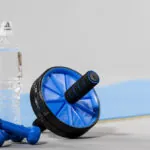Kettlebells are renowned for their ability to provide a full-body workout that not only builds muscle but also enhances endurance and coordination. This guide will introduce you to essential kettlebell movements and some advanced techniques that can transform your fitness regime. Let’s dive into the benefits of integrating kettlebells into your workout and explore some core movements to get you started.
Core kettlebell movements
Kettlebell training is about combining movement patterns that target multiple muscle groups at once, making it incredibly efficient for those short on time. Here are some foundational kettlebell exercises that are perfect for beginners and still effective for seasoned athletes to revisit.
Kettlebell swing
- Technique tips: Stand with your feet shoulder-width apart, holding the kettlebell with both hands in front of you. Bend your knees slightly and hinge at your hips to swing the kettlebell between your legs. Then, explosively drive your hips forward to swing the kettlebell up to chest height, maintaining a straight back and engaged core throughout the motion.
- Common mistakes: Avoid rounding your back or using your arms to lift the weight. The power should come from your hips and glutes.
Kettlebell goblet squat
- Technique tips: Hold the kettlebell close to your chest with both hands, feet just wider than shoulder-width apart. Squat down as if sitting in a chair, keeping your chest up and back straight. Push through your heels to return to the starting position.
- Common mistakes: Don’t let your knees cave in, and make sure to keep your torso upright throughout the squat.
Kettlebell Turkish get-up
- Technique tips: Start by lying on the floor, kettlebell in one hand extended straight above you. Keeping your eye on the kettlebell, sit up, then bridge your hips up, and bring your free leg under your body to kneel. Stand up while keeping the kettlebell overhead at all times.
- Common mistakes: Rushing through the steps without maintaining control of the kettlebell or your body posture.
Advanced kettlebell exercises
Once you’ve mastered the core movements and are looking for more challenging exercises to enhance your strength and coordination, consider these advanced kettlebell techniques:
Kettlebell snatch
- Technique tips: Similar to the swing, the snatch starts by swinging the kettlebell between the legs. Instead of stopping at chest height, you’ll continue the motion to bring the kettlebell directly overhead in one fluid movement.
- Common Mistakes: Losing grip on the kettlebell or failing to use the hip drive, relying too much on arm strength.
Kettlebell clean and press
- Technique Tips: Begin with the kettlebell between your feet. Clean the kettlebell to your shoulder by extending through the legs and hips as you pull the kettlebell towards your shoulder, rotating your wrist so it rests comfortably. Follow with a press, pushing the kettlebell above your head.
- Common Mistakes: Not securing the kettlebell in the rack position before pressing, which can lead to shoulder strain or an unbalanced press.
For more advanced exercises, you can mix kettlebells and battle ropes for an intense HIIT exercise also.
Creating a kettlebell workout routine
Designing an effective kettlebell workout routine involves understanding your fitness level and goals. To further activate the whole body, mix kettlebells with battle ropes.
Here’s how you can structure your routines:
Beginner’s routine
- Focus on mastering the form of basic moves like the kettlebell swing, goblet squat, and deadlift.
- Start with lighter weights to ensure you can perform each movement with proper technique.
- A typical session might include 3 sets of 10 swings, 10 goblet squats, and 10 deadlifts, with a minute of rest between sets.
For those wanting to focus specifically on core development, targeted kettlebell core routines provide dedicated progressions that complement these full-body movements.
Intermediate routine
- Incorporate compound movements such as the Turkish get-up and the clean and press to challenge multiple muscle groups.
- Begin to mix in cardiovascular elements by performing exercises in a circuit, minimizing rest between movements to keep your heart rate up.
- Example session: Circuit of 15 swings, 10 clean and presses per arm, and 5 Turkish get-ups per side, repeated 3 times.
Advanced routine
- Introduce more dynamic and challenging movements like the snatch and the double kettlebell movements.
- Focus on increasing the weight and complexity of the routines, implementing shorter, more intense workout segments with strategic rest periods.
- Advanced workout might include snatches for 15 reps per arm, double kettlebell squats for 10 reps, and double kettlebell swings for 20 reps, with active recovery periods of light jogging or stretching.
Final thoughts
Kettlebell training offers a comprehensive way to improve strength, flexibility, and cardiovascular health all at once. By mastering core movements and safely advancing to more complex exercises, you can enjoy a varied and effective workout routine that keeps you engaged and continuously challenging your body. Remember, the key to success with kettlebells lies in proper technique and gradual progression.





